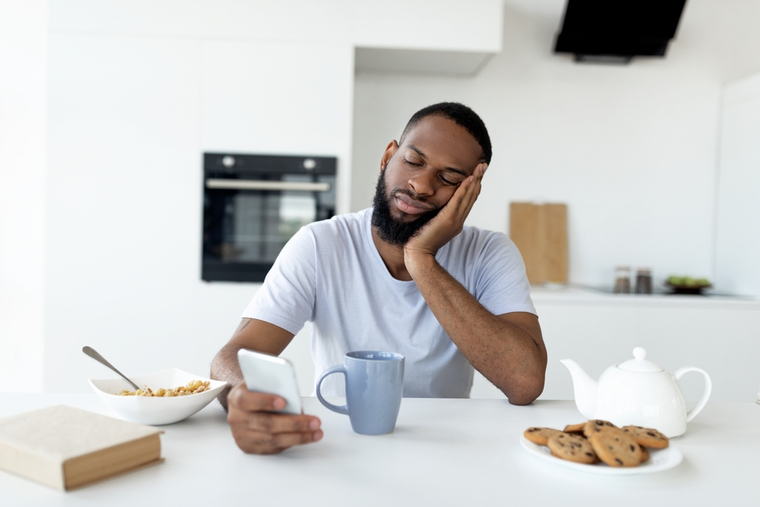Social media use associated with mixed outcomes when it comes to college students’ well-being during pandemic

New research from the lab of Renee J. Thompson shows social media use by college students increased during the first month of COVID-19 restrictions. The results were a mixed bag. (Photo: Shutterstock)
By Brandie Jefferson November 22, 2021
When students were told to stay home after COVID-19 began to spread stateside, it’s not surprising that their social media use increased — there wasn’t much else to do. But was it all doom scrolling and catastrophizing or was social media living up to its promise to keep people connected and strengthen our ties to one another?
Research from the lab of Renee J. Thompson, associate professor of psychological and brain sciences in Arts & Sciences at Washington University in St. Louis, suggests the answer depends on how you’re using it.

Higher social media addiction and increased exposure to COVID-related content was associated with lower social and emotional well-being.
Those who were lonelier during COVID engaged with social media less and used it less habitually.
“But some of those same factors are also associated with higher stress and anxiety related to the pandemic,” she said.
The results, Tuck said, held some surprises, but the overall trend revealed a more negative association with emotional well-being as social media use increased.
“When a client comes to me, or when a friend says, ‘Hey, I’m concerned about my social media use,’ it doesn’t really seem like the right answer is to say ‘Stop social media,’” Tuck said. Nor is the answer to go overboard and immerse yourself in your feed.
The right answer, she said, may depend on a person’s goals.
“Many, though not all, components of social media use are positively correlated with feeling more socially supported. So if your goal is to feel more socially supported, at least during the pandemic, maybe social media use is good. On the other hand, if you’re concerned about your stress or your emotional well-being, we’re also seeing social media use associated with feeling more negative, more stressed.”
No matter a person’s goals, it’s apparent that social media use is ubiquitous, pandemic or no pandemic.
In the years that Tuck has been looking into how social media affects well-being, she said, “I’ve yet to have a survey respondent say that they don’t use it.”
By Brandie Jefferson November 22, 2021
When students were told to stay home after COVID-19 began to spread stateside, it’s not surprising that their social media use increased — there wasn’t much else to do. But was it all doom scrolling and catastrophizing or was social media living up to its promise to keep people connected and strengthen our ties to one another?
Research from the lab of Renee J. Thompson, associate professor of psychological and brain sciences in Arts & Sciences at Washington University in St. Louis, suggests the answer depends on how you’re using it.

Thompson
The results were published online recently in the journal JIMR Formative Research.
“Social media use has mixed associations,” said first author Alison Tuck, a PhD student in Thompson’s lab. “Depending on whether you’re interested in social versus emotional well-being, we see different things.”
For the study, 176 college students participated in online surveys between April 14-24, 2020, just one month after the World Health Organization declared COVID-19 a pandemic.
To understand the basics of how social media use changed since before the arrival of COVID, participants were asked about their usage a month before spring break and the month or so after. This provided a clear line between “before COVID” and “during COVID” that was shared by all the participants; they all found out on the same day of their spring break that in-person classes would be canceled.
The surveys asked participants how much time they spent on social media pre- and post-spring break as well as basic questions about how much they engaged with and enjoyed the sites they visited; how content affected them emotionally; and how much COVID-related content they were exposed to after.
The pandemic had only just hit U.S. universities, so students could easily report on changes in their use, Tuck said.
There were not many surprises in the basic ways that social media use changed during COVID.
“We did see a significant increase in time per day spent on social media,” Tuck said. Average time spent on social media increased from about two hours a day before COVID restrictions, to three or more hours a day after. At the same time, people reported getting less enjoyment from social media and reported more negative emotions from social media use during COVID than before.
And, Tuck said, there was a significant increase in problematic social media use, measured by how impulsive and uncontrollable people’s use of social media was and how much it interfered with their lives.
To better understand how changes in social media use were related to people’s social and emotional well-being, participants were asked about how socially supported they felt before and after COVID restrictions were in place, as well as about their levels of emotional well-being, as assessed by stress and anxiety. Tuck was able to look at the changes in people’s well-being and compare them to their changes in social media use.
These results were not particularly straightforward.
“There were some positives in terms of social well-being,” Tuck said. The more frequently people used social media and the more time they spent on it, the more socially supported they reported feeling.
Other findings of interest
The results were published online recently in the journal JIMR Formative Research.
“Social media use has mixed associations,” said first author Alison Tuck, a PhD student in Thompson’s lab. “Depending on whether you’re interested in social versus emotional well-being, we see different things.”
For the study, 176 college students participated in online surveys between April 14-24, 2020, just one month after the World Health Organization declared COVID-19 a pandemic.
To understand the basics of how social media use changed since before the arrival of COVID, participants were asked about their usage a month before spring break and the month or so after. This provided a clear line between “before COVID” and “during COVID” that was shared by all the participants; they all found out on the same day of their spring break that in-person classes would be canceled.
The surveys asked participants how much time they spent on social media pre- and post-spring break as well as basic questions about how much they engaged with and enjoyed the sites they visited; how content affected them emotionally; and how much COVID-related content they were exposed to after.
The pandemic had only just hit U.S. universities, so students could easily report on changes in their use, Tuck said.
There were not many surprises in the basic ways that social media use changed during COVID.
“We did see a significant increase in time per day spent on social media,” Tuck said. Average time spent on social media increased from about two hours a day before COVID restrictions, to three or more hours a day after. At the same time, people reported getting less enjoyment from social media and reported more negative emotions from social media use during COVID than before.
And, Tuck said, there was a significant increase in problematic social media use, measured by how impulsive and uncontrollable people’s use of social media was and how much it interfered with their lives.
To better understand how changes in social media use were related to people’s social and emotional well-being, participants were asked about how socially supported they felt before and after COVID restrictions were in place, as well as about their levels of emotional well-being, as assessed by stress and anxiety. Tuck was able to look at the changes in people’s well-being and compare them to their changes in social media use.
These results were not particularly straightforward.
“There were some positives in terms of social well-being,” Tuck said. The more frequently people used social media and the more time they spent on it, the more socially supported they reported feeling.
Other findings of interest
Higher social media addiction and increased exposure to COVID-related content was associated with lower social and emotional well-being.
Those who were lonelier during COVID engaged with social media less and used it less habitually.
“But some of those same factors are also associated with higher stress and anxiety related to the pandemic,” she said.
The results, Tuck said, held some surprises, but the overall trend revealed a more negative association with emotional well-being as social media use increased.
“When a client comes to me, or when a friend says, ‘Hey, I’m concerned about my social media use,’ it doesn’t really seem like the right answer is to say ‘Stop social media,’” Tuck said. Nor is the answer to go overboard and immerse yourself in your feed.
The right answer, she said, may depend on a person’s goals.
“Many, though not all, components of social media use are positively correlated with feeling more socially supported. So if your goal is to feel more socially supported, at least during the pandemic, maybe social media use is good. On the other hand, if you’re concerned about your stress or your emotional well-being, we’re also seeing social media use associated with feeling more negative, more stressed.”
No matter a person’s goals, it’s apparent that social media use is ubiquitous, pandemic or no pandemic.
In the years that Tuck has been looking into how social media affects well-being, she said, “I’ve yet to have a survey respondent say that they don’t use it.”
No comments:
Post a Comment